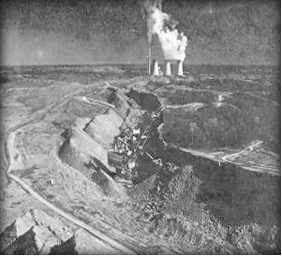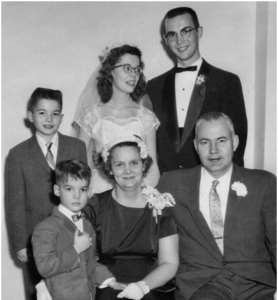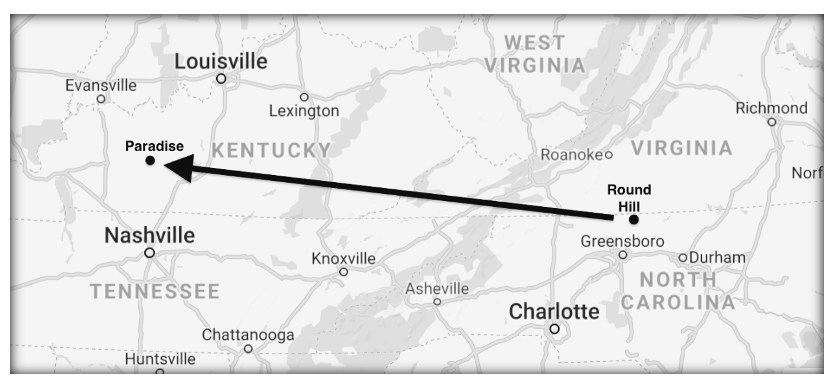Migration Route from Round Hill NC to Paradise KY
George R. Smith (1771-1840) and Lydia Jenny Tate
Father’s Great Great Grandparents, Caswell Co. NC to Posey, Indiana
There has been some confusion over the years regarding the name of George’s wives. I have seen stories referring to a Lydia, a Jean, Jenny and finally a Sarah Armstrong. I have borrowed from the work of Smith genealogist, Pearl Smith, and will also call the young lady, Lydia Jenny. And here’s why. Hang in here with me.
In his Last Will, Zaccheus Tait (aka Tate) refers to two of his daughters by name: Lydia and Jean. He further identifies Lydia as the wife of John Brown, and Jean as the wife of George Smith. Zaccheus Tait died in 1798, leaving many heirs.
A handwritten note dated the 20th day of December of 1800, indicates George Smith received a license to marry a Jenny or Jinny. No last name was given for the bride, but permission for the marriage was granted by a Zaccheus (sp) Tait. An official record of Caswell County (found in North Carolina, US, Marriage Records, 1741-2011) indicates George Smith married a Jenney Tait (sp) in 1800. Zaccheus Tate (sp) is identified as a witness. This Zaccheus is most likely Jenney’s brother, the son of the deceased father (1798), also named Zaccheus.
Was Jenny Tate Smith, also known as ‘Jean?’ Was she the same woman identified in the Last Will of Zaccheus Tate (d 1798) as Jean, the wife of George Smith? Did George Smith and Jean Tate have a common law marriage in 1798 and a licensed marriage in 1800? Will the Chicago Cubs ever win another World Series? The world is filled with questions for which I may never live to see the answer.
The confusion continues. A second record exists identifying a marriage between a Lydia Tate and George Smith, also in 1800, also in Caswell County. Go figure. Thus, the name ‘Lydia Jenny’ evolves as a way to compromise and create a character known as the first wife of George R. Smith, and mother of his first three children: Peter, Zach and Lydia. I’ll use Zach indicating my confusion when examing cursive writing that leaves doubt. Is it Zaccheus or Zachariah or a variation?
On August 14th, 1807, a George Smith marries a Salley Jackson. The marriage is witnessed by Thomas Jackson (Junr), in Caswell County.
Fifty years ago, a woman in California published findings in an Alabama newspaper, referencing a George Smith Jr marriage uniting George with a Sarah Armstrong, born December 17, 1784. This marriage occurs in Vincennes, Indiana, in May of 1810. That this Sarah Armstrong is married to George Rudolphus Smith is made clear in the Smith Cemetery, and in death certificates. The attachment of the ‘Junior,’ posted in the Alabama newspaper, is problematical, if not a false flag.
There was at least one other George Smith in Caswell County, and this second George is likely the man who married Salley Jackson.
George R Smith had a son named George C. Smith, but this son was born of Sarah, in Indiana c. 1826.
Sorting through all the marriages, and the numerous Smiths, is a bit of a conundrum. The marriage of George Smith and Jean Tate, referenced in the will of Zaccheus Tate raises the question: Is this George Smith the same man as George R. Smith of Round Hill?
Did this Jean Tate Smith pass away somewhere after the death of her father in 1798? Did this allow George to then marry Lydia Tate? Such a union would require that Lydia separate from John Brown prior to her 1800 marriage with George Smith. This is suspect. John Brown and Lydia are identified as married at the time of John’s death in 1826, while residing in Gibson County, Indiana.
Identifying George’s first wife’s, first name, is a challenge: Lydia, Jean, Jenny? All of the above? Go figure.
Regardless, George R Smith occupies a plot of ground in the Smith Cemetery on the Luke Heldt farm near Cyntithia, Indiana. The farm and cemetery are just off Water Tank Road, adjacent to Interstate 64. The tombstone identifies George R Smith, as “Died June 23, 1840.” The ‘4’ is faint and can be mistaken as a ‘1.’ The family also felt it important to provide an accurate time of George’s stay on Earth. The stone mason tells us George lived to be “68ys 2ms and 16ds.” We’re left to calculate the hours and minutes. Sarah Smith lies beside him, identified as the ‘wife of George R. Smith.’ The cemetery records provide some evidence:
“Smith, George R., son of Peter & Jemima (Simpson), b. 10 Apr 1772; Orange Co., NC; d. 23 Jun 1840.
Sarah (Armstrong), his 2nd wife and dau. of John & Mary (Swain) Armstrong, b. 17 Dec 1784; d. 24 Jun 1854.”
Smith, Zacariah Tate, son of Geo. R. & (1.) Jenny Tate, b. 24 Jan 1805 Muhlenberg, Ky.; d. 22 Aug. 1875.
Smith, William Bailey, son of Geo. R. & Sarah, b. 15 Mar 1811; Muhlenberg, Ky.; d. 15 Apr 1878.
Smith, Elsberry H., son of Geo. R., b. 18 Jan 1818; d. 29 Nov. 1886.
Susanna Mary Ann (Blackwell), his wife, b. 6 Oct. 1821; d. 11 Nov. 1893. Born Caswell Co., NC, dau. of Wm. H. & Elizabeth (Strader) Blackwell
Smith, George C., son of Geo. R, b. 6 Sep 1822; 4. 6 Oct. 1850.
Hornbuckle, Elizabeth, widow of Richard & dau. of Peter Smith of Caswell Co., NC,
b. 1792; 4. 8 May 1859, age 90 yrs.
That this George R. Smith had sons named Peter and Zacariah (sp) is evident in George’s Last Will. He granted each and a daughter named Lydia, three dollars. His remaining children are also identified in the will and they are treated differently than the first three, previously mentioned children. These additional progeny are the children of Sarah. Among her children, George identifies Elsberry as the executor of his estate. His oldest son, Peter was already a well established farmer, benefitting from George’s lifelong efforts. The names Zaccheus, Zacariah and Lydia are names common to the Tate family. The cemetery record identifying a son as Zacariah Tate Smith, if accurate, seals the deal. The name, Peter, is George’s father’s name and great grandfather’s name as well. He had numerous cousins and uncles named Peter. These records Smith Cemetery records strengthen George’s tie to the Round Hill Smith and Tate family history. The inclusion of Hornbuckles and Blackwells points to a second and third generation of family and friends that first organized in Fairfax County, Virginia c 1720.
The George R. Smith married to Sarah Armstrong was the same man responsible for the disposition of Round Hill, the Peter Smith estate. We know that somewhere along the way, in his commute from Round Hill NC to Indiana, George lost his first wife (and mother of his first three children).
Round Hill in Caswell County NC is forty miles north and a tad bit east of Greensboro, North Carolina. George R. Smith and his wife moved west from Caswell County into Kentucky at a time between the birth of Peter of Posey (b 1803) and his brother Zaccharius (b 1805).
George wasn’t the only family member heading west. His siblings and cousins, her siblings and cousins were moving in a huddled migration. They believed they were moving into paradise and when they arrived in their chosen hollow on the banks of the Green River, they called it Paradise.
The George Smith family journey from North Carolina to Indiana represents one of the several migration patterns found in the westward expansion of America. Along the way Smith siblings and cousins witnessed the expansion of tobacco fields, the growth of the cotton industry in the Carolinas, the growth of the coal industry in the hills of Kentucky and Illinois and the harvest of wheat and corn on the Great Plains. We will explore their transition from plantation owners to farmers and miners eking out a living on the western frontier. Their journey also captures the nature of the small world in which we truly live. George was traveling a trail into Kentucky blazed by his uncle William Bailey Smith (1737-1818).
The lives of our ancestors were interlaced in clockwork manner with a diverse number of families and faces, some famous in battle and governance, some known in religion and some forgotten. I am fascinated when I uncover each of our many ancestors, regardless of their stature.
Opportunities for career advancement in the hills of Kentucky and Indiana were rare and required a person’s ability to fire a rifle and till the soil. A review of the early census records for Kentucky, Indiana and Illinois reveal that men were farmers and women ‘housekeepers’ capable of working side by side with a man, and when necessary, alone. Census records initially recorded the birthplace of our ancestors as North Carolina and Virginia. In the span of a few decades Peter Smith of Posey, born in Caswell County NC, lived briefly in Kentucky with his parents and migrated with his father to Posey County, Indiana. In his later years Peter uprooted once more with adult son James Monroe Smith, and found himself in the coal fields of Franklin County, Southern Illinois.
But let’s not rush out of Kentucky just yet. You might recall the John Prine song Paradise, or not. You may be too young to have heard any number of singers belt the song out on the radio. If not, let me introduce you to the lyrics and your family connection to this piece of music and history.
Paradise KY 1910
Lyrics by John Prine
[Stanza 1]:
When I was a child my family would travel
Down to Western Kentucky where my parents were born
And there’s a backwards old town that’s often remembered
So many times, that my memories are worn.
Chorus:
And daddy won’t you take me back to Muhlenberg County
Down by the Green River where Paradise lay
Well, I’m sorry my son, but you’re too late in asking
Mister Peabody’s coal train has hauled it away
[Stanza 2]:
Well, sometimes we’d travel right down the Green River
To the abandoned old prison down by Airdrie Hill
Where the air smelled like snakes and we’d shoot with our pistols
But empty pop bottles was all we would kill.
Repeat Chorus: (And daddy won’t you take me back to Muhlenberg County…..)
[ Stanza 3]:
Stanza 3]:
Then the coal company came with the world’s largest shovel
And they tortured the timber and stripped all the land
Well, they dug for their coal till the land was forsaken
Then they wrote it all down as the progress of man.
Repeat Chorus
[Stanza 4]:
When I die let my ashes float down the Green River
Let my soul roll on up to the Rochester dam
I’ll be halfway to Heaven with Paradise waitin’
Just five miles away from wherever I am.
 All that is left of our forefather’s homeland is a cemetery standing on a knoll above the plant. The Clean Air Task Force attributes 13,000 deaths to the fine particle pollution from coal fired plants. There have been 2,000 victims of the Paradise Plant alone. Elderly and children are the most frequent victims. Such plants typically impact people living in high poverty areas as the companies avoid affluent neighborhoods where folks can afford attorneys and lobby politicians. President Trump hopes to eliminate all restrictions.
All that is left of our forefather’s homeland is a cemetery standing on a knoll above the plant. The Clean Air Task Force attributes 13,000 deaths to the fine particle pollution from coal fired plants. There have been 2,000 victims of the Paradise Plant alone. Elderly and children are the most frequent victims. Such plants typically impact people living in high poverty areas as the companies avoid affluent neighborhoods where folks can afford attorneys and lobby politicians. President Trump hopes to eliminate all restrictions.
The song was covered by John Denver, Jimmy Buffett and a host of other recording artists. Prine was a regular performer in the pubs and coffee houses on Wells and Clark Street in Old Town, Chicago when I was a younger man cultivating an interest in the music of Leo Kottke, Steve Goodman, Utah Phillips and Neil Young. Prine was discovered by Roger Ebert, Paul Anka and Kris Kristofferson and gained acclaim as a lyricist and recording artist.
 That’s a young John Prine to the left in the top row. The family portrait was taken on the day of his brother Dave’s wedding in 1957. His parents, William Prine and Verna Hamm are in the front row. The Prine and Hamm families were numerous in Muhlenburg County as were our Smiths. They were all neighbors and were related in one way or another.
That’s a young John Prine to the left in the top row. The family portrait was taken on the day of his brother Dave’s wedding in 1957. His parents, William Prine and Verna Hamm are in the front row. The Prine and Hamm families were numerous in Muhlenburg County as were our Smiths. They were all neighbors and were related in one way or another.
I had no idea, at the time that I was listening to Prine, that his song and the history it captured was relevant to my own life and that of my forefathers. I had no idea Prine’s ancestral family and mine broke bread together and shared church pews and classroom desks in the hills of Kentucky. I had no idea there were great grandparents and uncles in my tree responsible for the founding of the village of Paradise. Leonard Stom (1754-1814), designed and built a ferry service that made Paradise a valuable crossing on the Green River. It became a destination for pioneers on their journey into the Kentucky Wilderness. Leonard’s daughter, Judith, married my 4x great uncle Aaron Fairfax Smith (1783-1867). Aaron was the brother of our George Rudolphus Smith. Google ‘Smith in Paradise Ky’ and you will find the history. Most of the Smiths mentioned are descended from Peter Smith of Round Hill and Jemima Simpson.
When his first wife, Jenny (Jean) Tate died, George joined those early pioneers who were settling into southern Indiana. According to family lore, on his initial pass through the Indiana territory, looking for land and opportunity, he met and married his second wife, Sarah Armstrong.
George and Aaron Smith and their siblings were the founders of Paradise KY. Great Uncle Elias is buried in the Sears Vanlandingham Cemetery. His siblings, James Simpson Smith, John Bailey Smith, William Wiggington Smith, Martha Patsey Smith all passed away in Muhlenburg County. Most of them lived well into the 1850’s. They did not live to the see the construction of the Peabody mine or the destruction of their property. Their descendants did. The Peabody Coal Company organized in 1883 turned and turned Smith homesteads into an open pit.
What began as a trading post along the Green River no longer exists. The village was torn down in 1967 by the Tennessee Valley Authority. The proximity of the village homes to the nearby coal-burning electric operation, Paradise Fossil Plant, was determined to be a health hazard.
One century after the founding of Paradise KY, Smiths were found in the mines of Southern Illinois. Online records reveal the names of a number of Smiths, neighbors and friends who died tragically in mining catastrophes. I don’t know if you have seen the History Channel documentary on Mother Jones and her attempt to help the coal miners of this country, but our extended family benefitted from her efforts. If you are one who believes the union needs to be eradicated, you might want to savor the fact that our ancestors found some comfort in the brotherhood of the miner’s union. The fact that the union could resort to the bloody insurrection and tactics often employed is unforgivable. But they found it necessary to fight fire with fire. If you believe corporate America is good, capitalism great and can do no wrong, consider what happened to our family history as Mr. Peabody got the better of them. There must be some middle ground. This is just my plea for all things in moderation. Sorry to have stepped on the soap box for a moment. But, having researched this aspect of our family history, I fully understand my father’s progressive leanings.
On to Posey County, Indiana
George R. Smith packed up the wagons in Muhlenburg County KY with his life’s belongings and three children, Peter, Zaccharius and Lydia, brought into the world by his first wife. They established a home near the north shore of the Ohio River in Posey County, Indiana. His second wife, Sarah Armstrong (1784-1854), was the daughter of John Hardin Armstrong and Mary Polly Swain.
George lived in the township given his surname: Smith, as early as 1814. Documents reveal the purchase of his homestead. He built a horse drawn mill for grinding corn and wheat about 2 miles south of the village of Cynthiana. He ran a still on his property, exchanging a gallon of his good whiskey for a bushel of meal. I think I would be inclined to sell George all the corn meal I could rustle up at those prices!
His home was one of several polling places in Posey County elections in 1818. The man responsible for overseeing balloting was Sarah’s brother, Miles Armstrong. Elsberry and Miles Armstrong were the first settlers to purchase land in the township in 1810. The region was secured one year later by the United States government following the defeat of the Shawnee forces at the Battle of Tippecanoe in 1811. The name Elsberry was used often by Smiths and ties back to the Elsberry family of Virginia.
Much of my information regarding this time and location is taken from John Leffel’s 1913 masterpiece, The History of Posey County, Indiana. On page 47 Leffel drops the name of one James Farris who, in 1808, acquired land in Bethel Township. The surname caught my attention of course. After several drams of Scotch and the kind of brow beating research, I usually reserved for a legal hearing I still can’t prove that this Farris has anything to do with Grampa Leb’s middle name.
Faris women did marry men of the Smith family in South Carolina, Virginia and Indiana. They descend from Obadiah and Luke Smith of 17th Century Virginia. I found two other pioneer family names in our extended family. My Uncle Bill Smith married Margaret Robinson (Robbie), who grew up in southern Indiana. The township of Robinson in Posey County carries her maiden surname. Down the road from James Farris we find the early forerunners of a Hueguenot family, the Mounts (aka Mounce), several of whom married into the Smith clan. Indiana was granted statehood in December of 1816. State and local governments were soon organized. Smith township was officially dubbed as such in 1817 by the local trustees meeting in George Smith’s living room. I assume his whiskey sales had nothing to do with his popularity or his whiskey business as a choice location for a meeting of such importance.
Pedigree Chart 5: Six Generations of Great Grandparents




